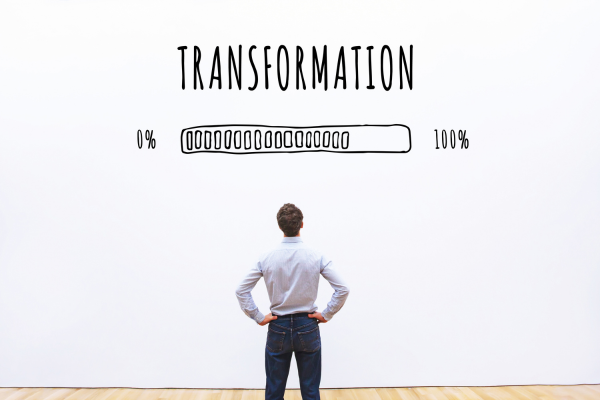The exponential growth journey to the Territory of Transformation can be long—and at times, challenging. And even when you’ve made your way to the other side of the Apex of Awareness on Mt. Mutatio and you’ve conquered the Four Fires of Fear it’s essential to remember that exponential growth is a lifelong path.
The next part of your journey calls for you to cross the 7 Cs. And when you get to this part of the journey, there’s no getting around these turbulent waters. These stormy Cs exist as far as the eye can see.
The waters of the 7 Cs are churning and chaotic—but in working with your team, you can band together to build a bridge that will take you to the shores of the Territory of Transformation in seven steps.

Step #1: Bridge Complexity with Calm
As technology expands and evolves, we step into an increasingly complex, interconnected world; networks, data streams, and supply chains that are undoubtedly efficient, but also quite expansive and unimaginably intricate. All this happens on a global scale, of course, but it happens on a much smaller scale, too.
When it comes time to transform ourselves, our work, or our teams, it can feel really complicated.
As individuals, the longer we’ve done something one way, the more daunting a new task or new way of doing things can feel. When we perceive something as complex, there’s a high probability that we will do whatever we can to avoid it.
But, if you want to transform, you have to acknowledge—and even embrace—that your transformation will be complex. Undoubtedly, there will be a point when your inner dialogue will become restless, doubtful, and confused, which will hinder your creativity and drive toward transformation.
So what do you do?
You work to calm and quiet this noisy inner critic—and you do it by being present in the moment.
Meditation helps. Mindfulness helps.
Naysayers will say this is just hippie stuff, but there is plenty of neuroscientific research to back up these claims. You don’t have to meditate for hours a day. If you try to sit still for an hour having never done so, you’ll wind up frustrated and distracted.
So start small.
Even just a few minutes of mindful breathing and reflection can land you in the present moment and help bridge complexity with calm.
Step #2: Bridge Confusion with Clarity
The first C is Complexity, but the second is Confusion—and they are closely tied to one another. Your mind must be calm to navigate complexity, and you must have clarity to overcome confusion.
Confusion descends upon us like a fog, trapping us in the status quo. We can’t see past it, which means we tend to feel safer staying where we are.
There are plenty of examples of financial brands staying where they are in the Age of AI. They feel confused and concerned about how they fit in with these concepts moving forward.
So they do nothing.
Through clarity, you can start to see things differently. But to do this, you and your team must be committed to continuous education. Education is what enables human transformation—and a strategic competitive advantage when it comes to digital transformation.
When you empower your team—when you commit to educating and learning and reskilling and growing—you can bridge confusion with clarity and find faster and greater innovation. Your teams share a common language and a common understanding.
You can work together.
Financial brands that cut education budgets—especially when times get tough and budgets are tight—may feel like they are making a smart decision in the short term, but what they’re actually doing is trapping their people in a dense fog, compromising their own future growth potential. Education is what helps all of us gain new knowledge, insights, and clarity. We discover new perspectives that challenge our biases and help us move past the fog of confusion.
Step #3: Bridge Chaos with Courage
Complexity leads to confusion—and confusion, in turn, leads to chaos. And while education supports clarity, that clarity doesn’t guarantee progress.
There’s a big difference between knowing and growing.
Napoleon Hill puts it slightly more poetically, though: “To become successful you must be a person of action. Merely to ‘know’ is not sufficient. It is necessary both to know and do.”
Taking action requires courage.
I’ll be honest: I’ve seen plenty of financial brand leaders work hard to gain clarity, only to sink to the depths of the 7 Cs or retreat to their Cave of Complacency, all because they couldn’t summon their courage.
Harnessing your courage is hard to do. It’s a battle fought in your subconscious.
Here’s the thing.
There will be times that you feel fearful—and I’m not saying you can’t experience fear. Or doubt. Courage comes into play when you work to conquer that fear.
Courage is also important in letting go of our heavy armor; our defense mechanisms. The need to be right, the need to hold onto posturing, the need to know it all. This armor is very common—we all have it. But it can lead to distrust, bad decisions, and conflict.
Instead of hiding under all this armor, when things get tough, or when things get chaotic, lean into vulnerability.
Admit when you don’t know something. Get curious. Open up your mind (and your heart) and continue to learn. Courage requires honesty and truth, as well as vulnerability to bridge chaos.
Step #4: Bridge Criticism with Commitment
At some point along your journey, you will face criticism. It can come from anywhere; a peer, a colleague, or a competitor. When this happens, you will start to worry that you are doing something wrong.
The thing about criticism, though, is that it’s not about you.
It’s a sign that your critic is the one struggling to keep their head above water. They are sinking to the bottom of the 7 Cs, and they don’t want to drown alone; they want to take you with them.
So what do you do?
When you face criticism, the best course of action is not to react at all. Don’t take things personally. Control your mind. Respond with empathy and kindness.
But don’t let yourself get dragged down, too.
Truthfully, sometimes, you may need to help the person who is working so hard to bring you down. I know. It’s hard. It’s the last thing you want to do when someone is being unkind.
But it really does work.
When we meet people where they are, we can gain a deeper understanding. We can work together. And then we can collaborate, grow, and learn from each other. Everyone benefits.
Unfortunately, sometimes our toughest critic isn’t an external source. Often, we are our own biggest critic. The reason has to do with our deep, inherent concern regarding what others think of us.
However, as the late David Foster Wallace shared: “You will become way less concerned with what other people think of you when you realize how seldom they do." After all, we’re all on this journey together, which means we must treat everyone—including ourselves—with kindness.
We must believe in our journey, and commit to it.
Step #5: Bridge Conflict with Community
You will also experience conflict on your journey toward exponential growth.
Think of conflict like a crack that forms in your bridge as you cross the 7 Cs. The more people on your journey, the sturdier your bridge needs to be to prevent collapse.
How do we achieve this?
By bridging conflict with a community of like minds committed to the cause.
Why?
Because transformation rarely happens alone. Our brains are wired to thrive in a community.
It’s why brands like Peloton grew exponentially during the pandemic; the brand enabled a community to come together to work toward a shared cause—health and well-being—when community was needed more than ever.
You already have the potential to achieve exponential growth, whether it be as an individual or as an organization, by overcoming conflict through the power of your community.
But be mindful that strong and thriving communities are not built in days, months, or quarters. Like all meaningful relationships, creating communities that bridge conflict requires time, effort, and energy over the long term.
Step #6: Bridge Complacency with Collaboration
When we are progressing along our journey of exponential growth, inevitably, we will reach a moment where we question everything. We get stuck. We lose our courage. We start to procrastinate.
We get complacent.
The solution to overcoming this complacency lies in collaboration. As a society, we’ve been conditioned to be self-reliant and work in isolation. But there is a tremendous growth advantage in shifting your thinking from wondering how to take the next step, or how to solve a problem, to who can you collaborate with?
It’s the concept of who before how: Thinking of who to collaborate with rather than how to take on a problem alone is what creates results.
Collaboration creates far more value than competition does. It creates a feeling of abundance, rather than a mindset of scarcity.
As Ronald Reagan once put it, “There is no limit to the amount of good you can do if you don't care who gets the credit.”
Step #7: Bridge Cowardice with Confidence
You’ve come a long way on your journey across the 7 Cs. It can be tiring, and you may feel like you will never get there. But the last thing you want to do at this point is spiral into self-pity. As Marcus Aurelius once wrote, “The most despicable form of cowardice is self-pity.”
If exponential growth was easy, everyone would do it.
You are going to struggle along the way—but the key is to keep this struggle in perspective. You will start to get uncomfortable. But transformation comes when you continuously push past this discomfort and cowardice, embrace the difficulties, and have faith in why you started on this journey in the first place.
In other words, you must find—and trust—your confidence. You have the confidence you need to get to the Territory of Transformation, but it means you must sometimes choose courage over comfort.
Confidence comes from doing what you set out to do. It comes with a continuous commitment to be disciplined and do hard things. And as a leader, you must work to protect your confidence. Get this right and you’ll only grow more confident over time as long as you don’t look too far ahead and let yourself feel defeated by how far you still have to go.
What’s Next?
Far too many people sink somewhere in the 7 Cs. They never achieve exponential growth. They don’t take action because they lack confidence, they don’t reach out to their community, or they listen to internal or external critics.
As a result, they struggle with difficult things while distractions send them down the wrong path. So commit to increasing your confidence by committing to do what you say you will do—because like courage, confidence is contagious. And when you commit, when you build bridges to overcome your obstacles, you’re that much closer to the exponential growth you’re seeking.
This article was originally published on May 25, 2024. All content © 2024 by Digital Growth Institute and may not be reproduced by any means without permission.





